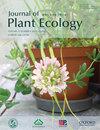Effects of land use on soil microbial community structure and diversity in the Yellow River floodplain
IF 3.9
2区 环境科学与生态学
Q2 ECOLOGY
引用次数: 6
Abstract
Soil microorganisms and their diversity are important bio-indicators of soil carbon and nutrient cycling. Land use type is a major determining factor that influences soil microbial community composition in floodplain ecosystems. However, how the structure and diversity of soil microbial communities respond to specific changes in land use, as well as the main drivers of these changes, are still unclear. This study was conducted in the Yellow River floodplain to examine the effects of land use type on soil microbial communities. Four land use types (shrubland, farmland, grassland, and forest) were selected, wherein shrubland served as the baseline. We measured soil microbial structure and diversity using phospholipid fatty acids (PLFAs). Land use type significantly affected total, bacterial, and fungal PLFAs, and the gram-positive/negative bacterial PLFAs. Compared with shrubland, peanut farmland had higher total and bacterial PLFAs and forest had higher fungal PLFAs. Soil pH and phosphorus were the predominate drivers of microbial PLFAs, explaining 37% and 26% of the variability, respectively. Soil total nitrogen and nitrate nitrogen were the main factors increasing microbial community diversity. Peanut farmland had the highest soil carbon content, soil carbon stock, total PLFAs, and microbial diversity, suggesting that farmland has great potential as a carbon sink. Our findings indicated that peanut farmland in the Yellow River floodplain is critical for maintaining soil microbial communities and soil carbon sequestration.土地利用对黄河泛滥平原土壤微生物群落结构和多样性的影响
土壤微生物及其多样性是土壤碳和养分循环的重要生物指标。土地利用类型是影响河漫滩生态系统土壤微生物群落组成的主要决定因素。然而,土壤微生物群落的结构和多样性如何响应土地利用的具体变化,以及这些变化的主要驱动因素仍不清楚。以黄河漫滩为研究对象,探讨了不同土地利用方式对土壤微生物群落的影响。选取灌丛地、农田、草地和森林4种土地利用类型,以灌丛地为基准。我们用磷脂脂肪酸(PLFAs)测定了土壤微生物的结构和多样性。土地利用类型显著影响总PLFAs、细菌PLFAs和真菌PLFAs以及革兰氏阳性/阴性细菌PLFAs。与灌木地相比,花生田的细菌PLFAs总量和真菌PLFAs均高于森林。土壤pH和磷是微生物PLFAs的主要驱动因素,分别解释了37%和26%的变异。土壤全氮和硝态氮是增加微生物群落多样性的主要因素。花生田土壤碳含量、土壤碳储量、总PLFAs和微生物多样性最高,表明花生田具有巨大的碳汇潜力。研究结果表明,黄河滩花生田对维持土壤微生物群落和土壤固碳至关重要。
本文章由计算机程序翻译,如有差异,请以英文原文为准。
求助全文
约1分钟内获得全文
求助全文
来源期刊

Journal of Plant Ecology
生物-植物科学
CiteScore
4.60
自引率
18.50%
发文量
134
审稿时长
3 months
期刊介绍:
Journal of Plant Ecology (JPE) serves as an important medium for ecologists to present research findings and discuss challenging issues in the broad field of plants and their interactions with biotic and abiotic environment. The JPE will cover all aspects of plant ecology, including plant ecophysiology, population ecology, community ecology, ecosystem ecology and landscape ecology as well as conservation ecology, evolutionary ecology, and theoretical ecology.
 求助内容:
求助内容: 应助结果提醒方式:
应助结果提醒方式:


